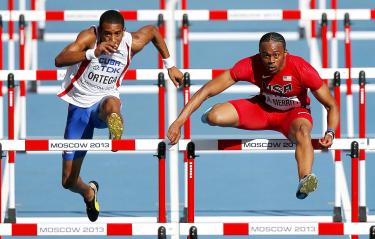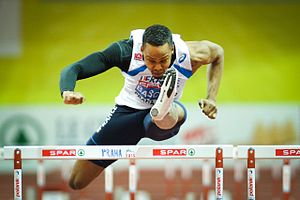June 29, 2017
When it comes to the lead arm, I’m a big proponent of keeping it as close to the natural sprinting motion as possible. It should not cross the body, but should drive straight up and straight down. Keeping the lead arm tight like this provides a tighter window for the trail leg to drive through when coming to the front. That way, the groin of the trail leg doesn’t open up excessively, but only just enough to enable a clean clearance of the obstacle. For examples of current hurdlers who employ this type of lead arm action, look at footage of Orlando Ortega, Keni Harrison, and Sally Pearson. The key is, the elbow stays below the hand when the hurdler takes off into the barrier.
 In the photo above, Ortega is on the left, racing against Aries Merritt on the right. Note how Ortega’s elbow stays below the hand as he attacks the crossbar. Upon descent, the hand will punch straight down, allowing the knee of the trail leg to drive upward/forward with minimal opening of the groin.
In the photo above, Ortega is on the left, racing against Aries Merritt on the right. Note how Ortega’s elbow stays below the hand as he attacks the crossbar. Upon descent, the hand will punch straight down, allowing the knee of the trail leg to drive upward/forward with minimal opening of the groin.
Meanwhile, I’ve noticed that there are other hurdlers who employ what I call a “swim move” with the lead arm. Instead of keeping the thumb pointing up and the elbow below the hand, they raise the elbow so that it is on level with the hand, and the palm of the hand is facing the track. From this position, they pull the air with the hand in a motion that mirrors how swimmers pull the water in order to thrust themselves forward. Dmitri Bascou of France comes to mind as someone who employs this style very well.
 The photo above shows Bascou’s lead-arm style. The palm faces downward, the elbow and hand are level to each other, and the hand will pull straight down upon descent.
The photo above shows Bascou’s lead-arm style. The palm faces downward, the elbow and hand are level to each other, and the hand will pull straight down upon descent.
Though I don’t teach this style, I go with it when the hurdler I’m coaching does it naturally. For male hurdlers particularly, raising the elbow may become a necessity, and it does allow for a forceful pull-down during descent off the hurdle. The key for me is, as long as the hand is not pulling the shoulders and hips off-line, then we’re good. If I see a twist in the hips and shoulders, then I know we need to make a correction. What I find is, as long as the palm faces down, and the pull-down is straight, no balance issues occur. But if the hand tilts a little bit further so that the thumb, not the palm, is facing downward, then the arm action during descent will pull the shoulder and hip on the trail leg side off-line.
In the video below, I was working with a middle schooler who also does multi-events in summer track. As you can see in the drill, the palm of her lead arm faces the track when she attacks the hurdles, and she employs the swim move I was talking about. At first I wanted to fix it, but when I saw that her hips and shoulders weren’t being negatively affected, I left her alone. However, she tends to clear the hurdles too high, with too much elevation, keeping her in the air too long. While I know that competing in the long jump and high jump in the heptathlon contributes to this tendency, I think that, from a purely technical standpoint, it is a result of raising the elbow. Like I said, some males need to do so because the hurdles are so high, but for females, raising the elbow tends to cause a more vertical take-off, shifting their momentum upward instead of forward. That is what is happening with my athlete in the video. So, for that reason, not because of balance issues, I will work with her on keeping the elbow below the hand and executing a straight up-and-down motion with the hand, with the thumb pointing up the whole time.
